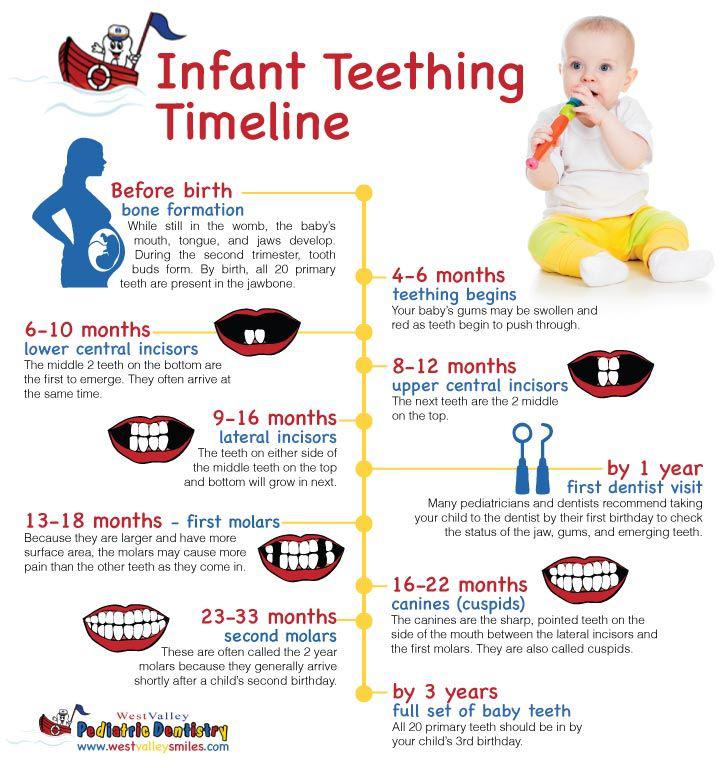
“She’s so touchy!” says Melanie Aguiar, mom to 14-month-old Ana. “The slightest little thing like falling down on her bum will start her crying.” Why is this usually sunny little girl so unhappy? Teething. “She’s cut four teeth in the last week and a half, including a molar,” says her mom.
Not only has Ana been irritable, but she’s been chewing on her fingers, her cheeks are bright red, and she’s had loose bowel movements. When Ana cut her first two incisors six months ago, she had a mild fever for three days, swollen gums and crying jags.
When a baby’s teeth begin to appear, it can really hurt, says paediatric dentist Raymond Lee, of the London, Ontario based Health Sciences Centre. “Cutting teeth essentially causes an open wound in the gum,” explains Lee. “The root is still developing under the gum line as the crown pushes through the gum.”
The symptoms
Parents report a variety of symptoms associated with teething: flushed cheeks, drooling and a tendency to chew on hands, diarrhea, diaper rash, runny nose and mild fever.
While loss of appetite and difficulty sleeping are attributable to pain, Lee acknowledges that some medical professionals aren’t convinced that teething can cause flu-like symptoms. “It’s largely anecdotal evidence, but I tend to trust Dr. Mom on this one,” he says. “It makes sense when you think about. The mouth is full of bacteria, so while I wouldn’t go so far as to call it an infection, it does make sense that the baby has a systemic reaction, which manifests as flu-like symptoms.” That said, it’s important to check with your doctor about flu-like or other respiratory symptoms to rule out an illness.
A predictable pattern
While babies differ in when they start teething, how it progresses is predictable. Teeth come in groups of four. On average, babies begin teething at six months and finish by 30 months in this sequence:
6–8 months – 4 lower incisors
8–10 months – 4 upper incisors
12–15 months – first molars
20–24 months – upper and lower eye teeth
20–30 months – second molars
What helps?
Pressure and pain relief are the keys to soothing sore gums, but figuring out what works for your baby is a matter of trial and error, says Lee. Pam Hummel’s daughter Cadence didn’t like cold things at all when she was teething, but gnawing on a hard bagel (well supervised) helped.
Cold and hard things Frozen wet washcloths, teething rings, an unopened Freezie — anything cold helps to numb tender gums. Be careful that any hard teething rings your baby uses are free of harmful chemicals, including phthalates and bisphenol A. There is a range of soft and hard organic cotton teething dolls and hardwood teething rings available (see Teething tools.)
Pressure If your child is OK with having your fingers in her mouth, rubbing her gums can be soothing.
Pain meds Both Hummel and Aguiar gave their babies an over-the-counter pain medications when their babies were having trouble sleeping. “It’s surprising how many parents don’t give acetaminophen or ibuprofen to relieve pain and swollen gums,” says Lee. “But they’re much safer and more effective than an oral gel. Gels that are rubbed on the gums contain about 20 percent benzocaine, a powerful anaesthetic,” explains Lee. I don’t recommend them because while they numb the gums for about 10 minutes, the risk is that if they are used continuously, the baby ingests too much. In extremely high amounts, benzocaine can cause problems with blood circulation. Lee says if parents are going to use the gel, it needs to be used very sparingly. One application might be enough to give your child the relief he needs to fall back to sleep at night.
Hummel and Aguiar gave their babies a homeopathic remedy for teething pain, which seemed to help. According to Lee, “caution is prudent with homeopathic remedies because sometimes we don’t know how they work exactly, especially if they are combined with other drugs. That said, if you use them as directed, and it works for your child, great.”
Cuddles Sometimes the best soother is some extra attention. “Cadence loved just being in my arms when her teeth hurt,” says Hummel.
Breastfeeding and teething
Most babies never bite or clamp down when breastfeeding, says Nanaimo, BC, lactation consultant Karyn-grace Clarke. But occasionally, while teething, they might. Here’s how to prevent it:
Ensure a good latch A baby who is properly latched has his tongue out and over the bottom gum ridge, which means he can’t clamp down. To bite, the baby has to pull his tongue back. “Pay attention during the feed,” says Clarke. “If the baby is going to bite, he will do so when he’s stopped feeding and is nibbling or playing at the breast.”
Don’t push the baby away If he clamps down, pushing away will make things worse. Instead, pull him in close to the breast tissue, which is uncomfortable and will cause him to let go.
Just say no! If he does clamp down, break the latch by sticking a finger in the baby’s mouth, and say very firmly, “No! That hurts Mommy!” Lay him down in a safe place and leave the room for a minute or two. With repetition, this will break the clamping habit, says Clarke.
Soothe baby’s gums Massaging sore gums before your baby feeds can reduce pain, so that he’s less likely to clamp down or bite. If he doesn’t like that, try giving him a clean face cloth soaked in expressed breastmilk.
Source: Todaysparent
 FR
FR EN
EN AR
AR








